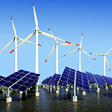- Home >
- Our Actions >
- Ambassador report
6
Comments
Urban Heat Island |
|---|
|
by Rohan Kapur | 24-08-2017 15:31
|
|
Urban Heat Island Last year we went to our ancestral village. Large & open farm lands, trees & river. It was summer time but we did not felt so much heat as we feel at home in the UAE. In the village even if we are sitting under a tree & wind is blowing the heat effect is minimised & we feel better. Nights were definitely cooler. While comparing the same in Dubai when I sat under a tree in a big park, I felt little better than that in the village. Taking the example further, I tried sitting under a tree that was planted in a landscaped area next to skyscrapers. Here I felt the hottest. Tree is same, greenery is same but there is this phenomenon called Urban Heat Island [UHI] effect. The giant concrete structures like sky scrapers, shopping malls, Asplat Roads, are all made of non-reflective and water-resistant construction materials. These materials act as heat sinks that absorb the radiated heat and store it for long time. Therefore, on a typical hot day the effect of heat will be felt more in these areas as compared with a park in the vicinity. Such Urban areas form a heat island within themselves and the temperature here is more than the air temperature. In the parks & green areas the air temperature may be felt but near to man-made structures the heat is felt more intense. Such a phenomenon is bad for the sustainability. Economy, People & Environment all suffer from UHI Effect. It increases the respiratory & air borne diseases. The demand of electricity increases as Air-conditioning is required to cool the heat this in turn increases the greenhouse effect. Demand for water also increases. Dubai has seen an increase of 1.5 degree Celsius rise in surface temperature due to UHI effect. The mitigation of this effect needs intensive planning. Since high rise buildings cannot be avoided, vegetated roofs may be planned. Usage of permeable materials or surfaces such as, porous pavement and grid pavers for road and parking spaces may be planned. Increase the use of high reflective materials with high solar reflective index panels on values for roofs and non-roof exterior surfaces. Simple measures like shading with trees may be planned. Surfaces may be covered with solar panels to augment solar energy. The key solution is increasing the landscaping as much as you can. This will reduce the UHI effect. Image Credits: weatherquestions.com, c3headlines.com |
  
|
|
|










 Previous : A short reminder from Poseidon...
Previous : A short reminder from Poseidon...









6 Comments
good work man be consistant
Posted 02-02-2018 16:35
the flowchart is amazing
Posted 02-02-2018 16:35
Thanks Arushi for useful inputs.
Posted 15-09-2017 00:51
Thanks for sharing your personal experience with respect to UHI phenomenon. Yes, agree with you that UHI effects can be mitigated. Strategies like planting trees, increasing shade around homes, having vegetative roofs/rooftop gardens, cool roofs, cool pavements (using carefully selected material) and specially large canopy trees around big buildings can do a big deal in mitigating UHI impacts.
Posted 30-08-2017 17:42
Sure & Thanks Aldrin. All innovative ideas are welcome. But my personal opinion is to have roof top garden so that it has some carbon positive impact as well. The roof may still be painted..
Posted 26-08-2017 14:07
Very interesting! I've read something about painting roofs white so as to be more reflective and absorb less heat which I think is one possible solution to UHI. What do you think?
Posted 24-08-2017 21:26